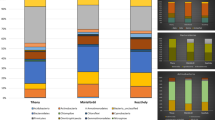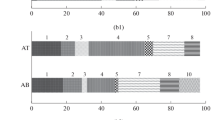Abstract
Molecular identification of the filterable forms of microorganisms in the water of the Rybinsk reservoir, one of the largest open water bodies in European Russia, was carried out. The number of ultrasmall microbial cells passing through 0.22 μm filters was 104 cells/mL. These were represented by both bacteria and archaea. Most bacterial 16S rRNA gene sequences retrieved from filtered water affiliated with the Betaproteobacteria and exhibited high similarity (99.0–99.5%) to those of bacteria of the genus Polynucleobacter. The archaeal 16S rRNA gene clone library was composed of the sequences from members of the Euryarchaeota, including the orders Methanobacteriales and Methanomicrobiales, as well as two archaeal groups (LDS and RC-V) with no characterized representatives. The species composition of filterable bacteria from reservoir water was different from that revealed previously in bogs and small lakes at catchment areas. By contrast, the pool of filterable archaea in the reservoir exhibited significant similarity to that at boggy catchment areas and was characterized by predominance of the clade LDS. Available data indicate that this archaeal group is typical of the northern freshwater ecosystems, and the organisms of this group are represented by ultrasmall cells.
Similar content being viewed by others
References
Rybinskoe vodokhranilishche i ego zhizn’ (Rybinsk Reservoir and Its Life), Leningrad: Nauka, 1972.
Fedotova, A.V., Belova, S.E., Kulichevskaya, I.S., and Dedysh, S.N., Molecular identification of filterable bacteria and archaea in the water of acidic lakes of Northern Russia, Microbiology (Moscow), 2012, vol. 81, no. 3, pp. 281–287.
Belova, S.E., Fedotova, A.V., and Dedysh, S.N., Prokaryotic ultramicroforms in a Sphagnum peat bog of the Upper Volga catchment, Microbiology (Moscow), 2012, vol. 81, no. 5, pp. 614–620.
Glissman, K., Chin, K.-J., Casper, P., and Conrad, R., Methanogenic pathway and archaeal community structure in the sediment of eutrophic lake Dagow: effect of temperature, FEMS Microbiol. Ecol., 2004, vol. 48, pp. 389–399.
Weisburg, W.G., Barns, S.M., Pelletier, D.A., and Lane, D.J., 16S ribosomal DNA amplification for phylogenetic study, J. Bacteriol., 1991, vol. 173, pp. 697–703.
Großkopf, R., Janssen, P.H., and Liesack, W., Diversity and structure of the methanogenic community in anoxic rice paddy soil microcosms as examined by cultivation and direct 16S rRNA gene sequence retrieval, Appl. Environ. Microbiol., 1998, vol. 64, pp. 960–969.
Schloss, P.D., Westcott, S.L., Ryabin, T., Hall, J.R., Hartmann, M., Hollister, E.B., Lesniewski, R.A., Oakley, B.B., Parks, D.H., Robinson, C.J., Sahl, J.W., Stres, B., Thallinger, G.G., Van Horn, D.J., and Weber, C.F., Introducing mothur: open-source, platform-independent, community-supported software for describing and comparing microbial communities, Appl. Environ. Microbiol., 2009, vol. 75, pp. 7537–7541.
Pruesse, E., Peplies, J., and Glockner, F.O., SINA: accurate high-throughput multiple sequence alignment of ribosomal RNA genes. Opens external link in new window, Bioinformatics, 2012, vol. 28, pp. 1823–1829.
Quast, C., Pruesse, E., Yilmaz, P., Gerken, J., Schweer, T., Yarza, P., Peplies, J., and Glockner, F.O., The SILVA ribosomal RNA gene database project: improved data processing and web-based tools. Opens external link in new window, Nucleic Acids Res., 2013, vol. 41(D1), pp. D590–D596.
Romanenko, V.I., Total numbers of bacteria in the Rybinsk reservoir, Mikrobiologiya, 1971, vol. 40, pp. 707–713.
Wang, Y., Hammes, F., Boon, N., and Egli, T., Quantification of the filterability of freshwater bacteria through 0.45, 0.22, and 0.1 μm pore size filters and shape-dependent enrichment of filterable bacterial communities, Environ. Sci. Technol., 2007, vol. 41, pp. 7080–7086.
Koch, A.L., What size should a bacterium be? A question of scale, Annu. Rev. Microbiol., 1997, vol. 50, pp. 317–348.
Maniloff, J., Nannobacteria: size limits and evidence, Science, 1997, vol. 276, p. 1776.
Psenner, R. and Loferer, M., Nannobacteria: size limits and evidence, Science, 1997, vol. 276, pp. 1776–1777.
Hahn, M.W., Isolation of strains belonging to the cosmopolitan Polynucleobacter necessarius cluster from freshwater habitats located in three climatic zones, Appl. Environ. Microbiol., 2003, vol. 69, pp. 5248–5254.
Hahn, M.W., Lang, E., Brandt, U., Wu, Q.L., and Scheuerl, T., Emended description of the genus Polynucleobacter and the species Polynucleobacter necessarius and proposal of two subspecies, P. necessarius subsp. necessarius subsp. nov. and P. necessarius subsp. asymbioticus subsp. nov., Int. J. Syst. Evol. Microbiol., 2009, vol. 59, pp. 2002–2009.
Wang, Y., Hammes, F., Boon, N., Chami, M., and Egli, T., Isolation and characterization of low nucleic acid (LNA)-content bacteria, ISME J., 2009, vol. 3, pp. 889–902.
Hahn, M.W., Broad diversity of viable bacteria in ‘sterile’ (0.2 μm) filtered water, Res. Microbiol., 2004, vol. 155, pp. 688–691.
Hahn, M.W., Scheuerl, T., Jezberova, J., Koll, U., Jezbera, J., Simek, K., Vannini, C., Petroni, G., and Wu, Q.L., The passive yet successful way of planktonic life: genomic and experimental analysis of the ecology of a free-living Polynucleobacter population, PLoS One, 2012, vol. 7, no. 3, e32772. doi: 101371/journal.pone.0032772
Sait, M., Hugenholtz, P., and Janssen, P.H., Cultivation of globally distributed soil bacteria from phylogenetic lineages previously only detected in cultivationindependent surveys, Environ. Microbiol., 2002, vol. 4, pp. 654–666.
Kotelnikova, S., Macario, A.J.L., and Pedersen, K., Methanobacterium subterraneum sp. nov., a new alkaliphilic, eurythermic and halotolerant methanogen isolated from deep granitic groundwater, Int. J. Syst. Evol. Microbiol., 1998, vol. 48, pp. 357–367.
Bräuer, S.L., Cadillo-Quiroz, H., Ward, R.J., Yavitt, J.B., and Zinder, S., Methanoregula boonei gen. nov., sp. nov., an acidiphilic methanogen isolated from an acidic peat bog, Int. J. Syst. Evol. Microbiol., 2011, vol. 61, pp. 45–52.
Barberán, A., Fernández-Guerra, A., Auguet, J.-C., Galand, P., and Casamayor, E.O., Phylogenetic ecology of widespread uncultured clades of the kingdom Euryarchaeota, Mol. Ecol., 2011, vol. 20, pp. 1988–1996.
Author information
Authors and Affiliations
Corresponding author
Additional information
Original Russian Text © A.V. Fedotova, Yu.M. Serkebaeva, V.V. Sorokin, S.N. Dedysh, 2013, published in Mikrobiologiya, 2013, Vol. 82, No. 6, pp. 715–722.
Rights and permissions
About this article
Cite this article
Fedotova, A.V., Serkebaeva, Y.M., Sorokin, V.V. et al. Filterable microbial forms in the Rybinsk water reservoir. Microbiology 82, 728–734 (2013). https://doi.org/10.1134/S0026261713060052
Received:
Published:
Issue Date:
DOI: https://doi.org/10.1134/S0026261713060052




